
In fact, it is not difficult to prepare meals for diabetics, we are not talking about any special diet. In type 1 and type 2 diabetes, a balanced diet plays an important role, which is suitable not only for the sick but also for the healthy.
No.
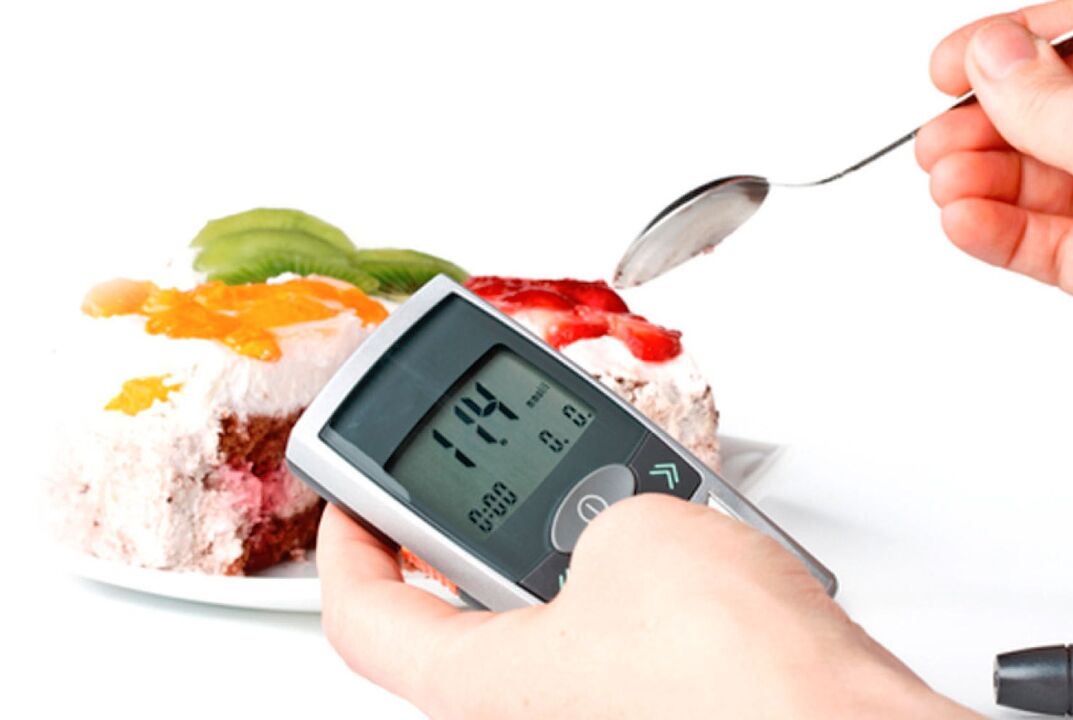
The first fact is that nutrition for diabetes involves limiting all direct sugar: diabetes dishes (first, second course and even desserts) are free of sugar or honey, sweet foods are excluded - cakes, ice cream, desserts (apple cake, fruit pudding), pancakes o. s. frv. ), cookies, sweets, cakes, chocolate, sugary drinks and juices, etc. , fatty and fried foods, fatty meats and sausages, beer, alcohol, white or black bread (usually caramel is added to it) and all white flour products.
In addition, dried fruits, grapes, plums and pears should be avoided. With regard to alcoholic beverages, exclude beer, drink only dry wine, up to 200 ml per day, consume strong alcoholic beverages only as a last resort and very clean. Remember to include alcohol in your daily calorie intake.
Yes
Just eat wholemeal bread. Meat can be cooked, but only, lean!
Be careful with side dishes, if you want to cook dumplings or dumplings, do not forget to monitor the dosage. Rice, pasta, potatoes are more suitable.
For diabetes, recipes should include vegetables (which should also be eaten raw) because they contain vitamins, minerals, protein and almost no (or minimal) sugar. Of vegetables, you need to limit carrots, beans and corn. Fruit can be eaten at most once a day, preferably as a morning snack.
It is advisable to divide the food into 4-6 small meals a day, make a light snack in the evening. Recipes for diabetes and the amount of food should be chosen depending on whether your body weight is within normal limits or needs to be reduced, as well as according to how much you exercise during the day.
For all diabetics it is appropriate and recommended to exercise for at least 30 minutes a day; brisk walking, running, swimming, cycling o. fl. works well.
You need to take at least 10, 000 steps a day.
It is quite understandable that sometimes the diet plan seems unbearable and irresistible desire to eat something of "forbidden" is expressed. Once a month, you can relax and treat yourself to dark chocolate (chocolate is suitable for cooking or contains 60-70% cocoa).
If you decide to change your eating habits, it is recommended that you first consult your doctor or specialist, such as your diabetes doctor, about subsequent changes in your antidiabetic drugs and insulin doses, if any. It is advisable to perform self-monitoring using a glucometer.
Diet and treatment measures are essential (neither treatment, nor insulin, etc. ), and are the basis of successful treatment for all diabetics! These facts are confirmed by a large number of specialized scientific studies in our country and in the world.
Diet for diabetes
Prohibited products:
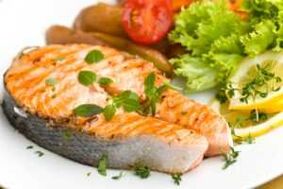
- Fatty dairy products.
- Egg yolks and their products.
- Hot dogs.
- Fatty meat - goose, duck.
- Heavy alcohol.
- Free sugar.
- Sweets.
- Salty snacks - chips, nuts, snacks o. fl.
Recommended products:
- Fats - butter, margarine, milk and dairy products - are all low in fat.
- Meat - young animals (veal, pork, lamb, chicken, rabbit, turkey).
- Fish - freshwater and sea.
- Deer.
- Ham - in small quantities.
- Vegetables - all kinds, including legumes.
- Fruits - in small quantities.
- The bread is whole wheat.
Technical methods that can be used are welding, stewing, grilling, rarely - frying.
Below are some recipes for diabetes, ranging from soups and main courses to desserts, suitable for diabetes.
The amount of ingredients contained in the following diabetes recipes is designed for 4 servings.
Food soups for diabetics
Soybean soup
Raw material:
60 g soybeans, 20 g flour, 20 g butter, 20 g onions, garlic, parsley, salt.
Preparation:
Boil soybeans until they are cooked or canned. Add finely chopped onion to butter, add flour and add hot water. Simmer, add boiled soybeans, chopped garlic with salt and chopped parsley. Cooked soup is best consumed hot.
Main meals in the diet for diabetics
Fried flounder
Raw material:
600 g flounder, 20 g butter, salt, pepper, 10 g flour, 1 lemon.
Preparation:
In flour mixed with salt and ground pepper, wrap the fish portions, drizzle with oil and grill. Season the prepared dish with lemon juice and garnish with lemon wedges.
Gúllas
Raw material:
320 g of meat (beef, veal, pork, rabbit, but best of all - a variety), 200 g of tomatoes, 40 g of oil, 1 onion, 20 g of potatoes, salt, parsley, marjoram, cumin.
Preparation:
Quickly fry the peeled pieces of meat in oil and cover with hot water. Add salt, chopped tomatoes, peeled whole onions and simmer. When the meat is almost tender, add peeled, finely grated raw potatoes, ground cumin and marjoram. Remove the onion from the ready-made stew (if it is cooked, leave it) and add finely chopped parsley.
Diet vegetarian dishes for diabetics
Stuffed tomatoes
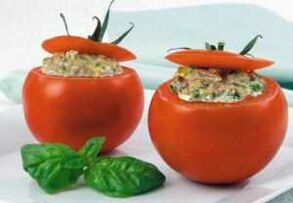
Raw material:
4 large hard tomatoes, 120 g of poultry, 20 g of rice, 20 g of butter, 1 egg, salt.
Preparation:
Cut the tops of the washed tomatoes and remove the middle. Boil washed rice in salted water, mix with minced poultry, salt, add the beaten egg and mix well.
Fill the prepared tomatoes without the center with the resulting mixture, cover them with cut tops and place in a lightly oiled container. Add hot water and simmer, done.
Boil the removed core, grind and add to the prepared dish.
Vegetable risotto
Raw material:
160 g rice, 20 g carrots, 20 g cauliflower, 15 g celery, 15 g parsley, 10 g corn, oil, parsley, salt, 120 g hard cheese.
Preparation:
Cut all peeled vegetables into cubes or shred on a coarse grater. Cut off the base of the cauliflower and divide the head into small flower petals. Rinse the grain. Rinse the rice, add oil, water, salt and simmer. After a while, add the prepared vegetables and simmer until tender. Serve ready-made risotto, sprinkled with chopped parsley and grated hard cheese.
Diet cold meals for diabetics
Cottage cheese with vegetables
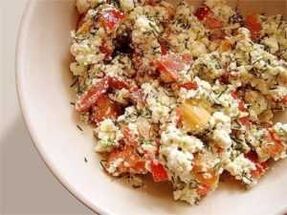
Raw material:
200 g cottage cheese, 40 g of milk, 1 tomato, 20 g of leeks, 40 g of cucumber, salt, ground cumin.
Preparation:
Peel the tomatoes, remove the seeds from the pulp, peel the leeks and cut into thin strips, grate the cucumber on a coarse grater.
Whisk the salted cottage cheese with a ladle of milk.
Add all the prepared vegetables to the resulting curd and grind the cumin to taste.
Shirt snack
Raw material:
200 g cottage cheese, 2 garlic cloves, sesame seeds, salt, green onion, dill, parsley.
Preparation:
Salt the garlic and mix with the cottage cheese. Dilute with water if necessary to form a dense mass. Finely chop the green onion and stir in the sesame seeds. Shape a roll of the boiled garlic mass, wrap in a mixture of green onions and sesame seeds so that the surface is completely covered. Allow the finished rolls to cool to harden.
Diet salads for diabetics
Apple and chicken salad
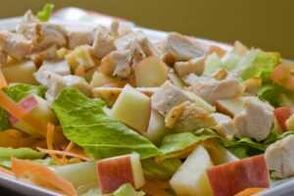
80 g carrots, 60 g bean sprouts, 200 g sour apples, 100 g cooked chicken breast, salt, 10 g butter, lemon juice.
Preparation:
Grate the peeled carrots on a coarse grater, wash the apples, remove the seeds, cut into slices and then into thin strips, just like ready-made chicken.
Mix all the prepared ingredients together, add bean sprouts, salt, drizzle with oil and lemon juice. Stir well again and allow to cool.
Five myths about diabetes
Diabetes is a chronic, lifelong disease that has complications. The people they encountered must learn to live with it and adapt their rhythms and lifestyles to it. Although this topic is widely discussed in the community, there are still many myths about this disease. Let's look at the main ones. Then…
Myth: Diabetes is a disease of obese patients.
People rarely recognize the difference between type 1 and type 2 diabetes. Type 1 diabetes can develop in childhood. The disease is genetically determined, insulin treatment is needed. In contrast, type 2 diabetes is often associated with obesity as mentioned above. The disease is characterized by a slow onset.
Myth: Diabetes is an "older" disease.
As there are many obese children and adolescents today, type 2 diabetes is increasingly affecting younger age groups.
Myth: Diabetics should never eat sweets and must follow a strict diet.

Of course, diet is important, but it's not about wasting carbs altogether. Diabetics cannot eat simple sugar (glucose), beet sugar (sucrose) and honey. However, they can use artificial sweeteners. Diabetics should eat complex carbohydrates (starch).
With diabetes, sweets can only be replaced by sweets - sweeteners, fruits. For example, you can eat two or three peaches, two oranges or three apples. Or you can eat something made with sweeteners.
Nutritionists recommend making sweets at home, this approach ensures that dishes are free of harmful preservatives and additives. From available and acceptable products, you can prepare any delicacy and treat yourself and your loved ones to a delicious dessert.
Myth: Diabetics can eat well, they just need to eliminate sugar.
As mentioned, diabetes management involves controlling carbohydrate intake. Complex carbohydrates should be present in your diet every day in the same amount as your doctor decides. Prescribed amounts need to be distributed throughout the day, as diabetes must be eaten regularly. The principles of a diabetic diet are in line with the principles of nutritional balance, so it is not just about controlling the sugar content but the overall composition of the diet. The essence of the disease lies not only in the metabolic diseases at the carbohydrate level, but also protein and fat.
Myth: Diabetics can eat as much fruit as they want.
Fruits contain a certain amount of carbohydrates. Obviously, this is the content of those who should have diabetes in their daily diet. That way you can not eat fruit in any quantity. It is advisable to choose the types that contain a minimum amount of carbohydrates and are high in fiber, which are important for digestion.














































































